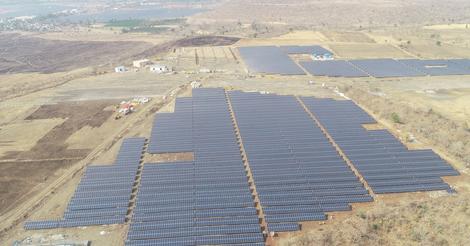Thanks to a new Power Purchasing Agreement (PPA) signed with India’s largest solar power producer, over half of the electricity needs of Solvay’s production facility in Roha, Maharashtra will be covered by a brand-new solar power plant starting next year, avoiding an estimated 3.9 kilotons of CO2 emissions each year.
As part of Solvay’s recently increased environmental ambitions, the Group is hard at work switching wherever possible to renewable energy sources for its sites around the world. To do that, Solvay’s Sustainable Energy team is constantly on the lookout for new ways to reduce the carbon footprint of its energy procurement.
One way of achieving this is by signing Power Purchase Agreements with renewable electricity producers. By making a long-term commitment to buying a fixed amount of the power they generate, Solvay contributes to the financing of clean energy projects.
About 50km south of Mumbai, the Roha plant is part of the Group’s Novecare global business unit and produces ingredients for home and personal care products. The new PPA for this site reinforces Solvay’s stance in the country in terms of renewable energy.
"This is our flagship project, and a real contribution to reducing our emissions, and as it’s a very long-term PPA (over 15 years), it’s a win-win: it secures revenue for the producer, and we get to buy power at an attractive price." says Mathilde Mathieu, Renewable Business Models & Contract Manager in Solvay’s Sustainable Energy team.
One particularity about this PPA signed with Fourth Partner Energy, India’s largest solar power producer, is that Novecare has invested equity in the project. A small investment which is demanded by local regulation in order to support even more directly renewable energy projects.
As it turns out, with 60% of its electricity consumption covered by the PPA and with renewable power now actually cheaper than conventional power purchased from the grid, Roha is set to make savings on its energy costs, in addition to avoiding several kilotons of CO2 emissions every year.
One caveat is that consumption must match production in real time: a company can only commit to buying as much solar power as it can consume at any given moment. Solvay is one in a list of the solar plant’s “offtakers”, companies that each signed up to buy a share of the electricity it produces and set its target at a usage of 2.45MW out of the facility’s 38MW overall power. “We had to find the right balance so we could maximize the amount of power we purchase without buying more than what we are capable of consuming,” explains Mathilde. “It’s quite a complicated equation, due to the variability of solar production and regulatory limitations.”
With increasing demand from corporations to source clean power and a limited amount of renewable energy projects to go around, in part because they’re so complex to put together from a financial and regulatory standpoint, securing supply is a strategic priority which isn’t that easy to fulfill, explains Anne-Charlotte Butrot, Sustainability Project Manager at Novecare.
The solar park, which is located a few hundred kilometers inland in Katol, Maharashtra, is now well underway: its financing fully secured by offtaker investments and purchase agreements, its construction has begun. The Roha plant will start receiving its green power early 2022.
